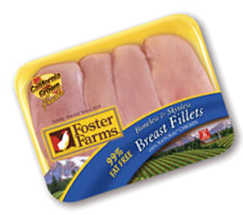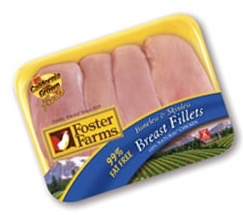An Arizona federal court jury awarded a family nearly $2 million in damages after their toddler experienced a brain injury from a Foster Farms chicken tainted by salmonella.
 Just days after his grandmother and cousin became sick from different strains of salmonella in late 2013, then 17-month-old Noah Craten suddenly came down with a fever, chills and diarrhea, according to the Arizona Republic. But doctors initially didn’t think the salmonella bacteria — one of the most common causes of food poisoning usually attributed to contaminated foods like eggs, poultry and meat— was the cause of his symptoms.
Just days after his grandmother and cousin became sick from different strains of salmonella in late 2013, then 17-month-old Noah Craten suddenly came down with a fever, chills and diarrhea, according to the Arizona Republic. But doctors initially didn’t think the salmonella bacteria — one of the most common causes of food poisoning usually attributed to contaminated foods like eggs, poultry and meat— was the cause of his symptoms.
But just a few weeks later in October, Noah was admitted to the hospital after experiencing an extended fever, and after conducting scans, doctors found an infection in the front of his brain that had created an abscess, placing pressure on the rest of his brain.
“I lost it. I was hyperventilating and hysterical,” Noah’s mother, Amanda, told the publication. “I wanted someone to fix him and bring him back to me. I couldn’t see him like that.”
The young boy then underwent surgery to remove a portion of the abscess, and doctors soon discovered it was caused by a rare strain of multidrug-resistant salmonella known as Salmonella Heidelberg.
“When we found out the abscess was from salmonella,” she said, “I instantly lost my composure and cried my eyes out.”
At the time of the discovery, Foster Farms was experiencing an outbreak of the salmonella in its products, which led to the hospitalization of at least 241 people throughout the country. The outbreak began in March 2013, and wouldn’t be declared over by the Centers of Disease Controluntil July 2014.
Noah received antibiotic treatments for the following seven weeks to shrink the rest of the abscess, and while he eventually seemed to improve, the toddler began to show signs of developmental damage such as facial tics and a stutter.
“We were devastated,” Amanda told the newspaper. “It’s been slowly, like every six months, we have a new problem.”
After seeing the damage done to their boy, Amanda and her husband, James Craten, sued Foster Farms for negligence and liability in their part of the salmonella outbreak.
“Foster Farms had known for years that it had a problem with Salmonella in its raw chicken, both from its own internal testing and from prior outbreaks to which Foster Farms had been linked,” one of the Cratens’ lawyers, Eric Hageman, told PEOPLE in a statement. “However, it failed to take steps to mitigate or eliminate Salmonella in its chicken, primarily because the USDA does not have a zero-tolerance policy for Salmonella on raw chicken (as it does for E. coli in ground beef).”
On March 1, an Arizona federal court awarded the family $1.95 million based on epidemiological and microbiological evidence that pointed to the company’s role in Noah’s illness.
In a statement to PEOPLE, Foster Farms said that there was no evidence presented in the trial that showed the family had purchased one of their products leading up to Noah’s symptoms.
“Every consumer has the right to expect safe and wholesome food. Salmonella-related illnesses can trace to any number of causes, including chicken,” the company said. “During the course of the trial, no evidence was presented that demonstrated the Craten family had purchased Foster Farms chicken in the six months prior to Noah Craten’s illness.”
The jury valued the damage to Noah at $6.5 million, and deemed Foster Farms 30 percent responsible — coming out to $1.95 million — and the family 70 perfect responsible, as the food that infected Noah was likely not prepared correctly, as salmonella is typically killed while the food is cooked. The money will all be set aside for Noah.
It is still unclear whether Foster Farms will appeal the verdict, and the family tells the Arizona Republic that they’ll likely only be left with almost half of their award once they pay off fees.















